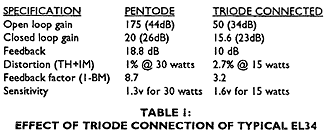Triode connected power tubes will reduce the power output if that's what you want. If so, I'd advise you to use the VRM instead.
Triode Connection
The first step for many towards pure triodes is to connect the screen grids to the plates of their present amps output tubes and listen for a while... just to see what it sounds like and find out if there is enough power left to drive their present speakers. But... are we really listening to just a triode version of our present amp or some new hybrid?
When we connect the screen grid to the plate (usually with a 100 ohm, 1/2 watt resistor to suppress RFI) we really do get a new tube. A funny triode with a bunch of wires in the electron path. Some believe these leftover wires cause problems but we won't go into that here. This new tube has a more linear loadline, lower plate resistance, lower gain, and higher trans conductance.
This would be fine, but our present amp was not designed for this tube. Changing these characteristics of the output stage changes the electrical structure of the whole amp. These changes are significant and are more than likely what we hear when listening to our new amp. Let's look at some ‘before and after' amp specs (Table 1 below).
Attachment:
 table1.gif [ 5.4 KiB | Viewed 8231 times ]
table1.gif [ 5.4 KiB | Viewed 8231 times ]
The numbers are approximate, but they illustrate exactly what is happening with a typical EL-34 amp. When we connect a tube in triode, we typically reduce the distortion of that stage by one-half. However, designers choose tubes primarily for their gain characteristics. In this case, the gain of the new tube is less than one tenth of the gain of the old tube. This changes the overall gain structure of the amp (see G. Rankin's article) and most importantly, it modifies the "gain reduction factor" due to feedback. Simply stated, feedback reduces distortion by a factor equal to the inverse of the gain reduction factor. Real simple? No?
Let me try again. When we switch to triode we reduce the gain and sensitivity of the amp causing us to use a bigger signal from our preamp. So why do many find happiness in triode connected pentodes? I suspect it's because a 10dB reduction in feedback makes the amp sound more ‘relaxed' and less bright. Feedback can thin out the sound, so this kind of reduction can give the new amp more fullness of presentation. Due to the above considerations, bandwidth and damping factor are reduced slightly, giving the amp a softer feel.
Output power is cut in half but many have noted that the apparent power in triode connected amps seems increased. This is because the amp now goes into and out of clipping more gracefully. Less sensitivity and less feedback allows us to drive these amps harder with less signs of distress. The more than doubled distortion shows up mostly as noise or lack of transparency. This can be corrected but would require a redesign of the amp.
Is it then a wise idea to convert? Yes and no. For many systems, the result of this change would be an increased enjoyment of recorded material and this is what we are looking for. It is certainly an easily reversible mod in any event. In a purist system, however, it would represent a compromise and the listener is advised to seek out a pure triode amp.


